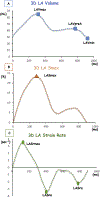Sex Differences in the Association of Cumulative Body Mass Index from Early Adulthood to Middle Age and Left Atrial Remodeling Evaluated by Three-Dimensional Echocardiography: The Coronary Artery Risk Development in Young Adults Study
- PMID: 32336609
- PMCID: PMC7388576
- DOI: 10.1016/j.echo.2020.02.013
Sex Differences in the Association of Cumulative Body Mass Index from Early Adulthood to Middle Age and Left Atrial Remodeling Evaluated by Three-Dimensional Echocardiography: The Coronary Artery Risk Development in Young Adults Study
Abstract
Background: The relationship between long-term obesity and left atrial (LA) structure and function is not entirely understood. We examined the association of cumulative body mass index (cBMI) with LA remodeling using three-dimensional (3D) speckle-tracking echocardiography (STE).
Methods: The Coronary Artery Risk Development in Young Adults (CARDIA) study is a community-based cohort of black and white, men and women, ages 18-30 years at baseline in 1985-86 from four U.S. centers. This study included 2,144 participants who had satisfactory image quality and body mass index measurements during the entire follow-up period. The 3D STE-derived LA parameters were maximum, minimum, and pretrial contraction volumes; total, passive, and active emptying fraction; maximum systolic longitudinal strain; and early and late diastolic longitudinal strain rates. Multivariable linear regression analyses stratified by sex assessed the relationship between cBMI and 3D STE-derived LA parameters, adjusting for demographics and traditional cardiovascular.
Results: The mean age of the cohort was 55 ± 3.6 years; 54.8% were women, and 46.5% were black. There were statistically significant additive sex interactions for the association between cBMI and LA minimum contraction value, maximum systolic longitudinal strain, and early and late diastolic longitudinal strain rates. In the fully adjusted model, greater cBMI was associated with lower magnitude LA longitudinal deformation (maximum systolic longitudinal strain and early and late diastolic longitudinal strain rates) in men and with higher LA emptying fraction in women. In addition, greater cBMI was associated with higher LA phasic volumes indices in both men and women.
Conclusions: This study showed that while greater cBMI from early adulthood throughout middle age was associated with higher LA volumes in both genders, differences were found for LA function, with lower longitudinal deformation in men and higher reservoir and active LA function in women.
Keywords: 3D echocardiography; Body mass index; Gender; Left atrium remodeling.
Copyright © 2020 American Society of Echocardiography. Published by Elsevier Inc. All rights reserved.
Conflict of interest statement
Conflicts of Interest: None.
Figures




Similar articles
-
Cumulative blood pressure from early adulthood to middle age is associated with left atrial remodelling and subclinical dysfunction assessed by three-dimensional echocardiography: a prospective post hoc analysis from the coronary artery risk development in young adults study.Eur Heart J Cardiovasc Imaging. 2018 Sep 1;19(9):977-984. doi: 10.1093/ehjci/jey086. Eur Heart J Cardiovasc Imaging. 2018. PMID: 29982431 Free PMC article.
-
Left atrial morpho-functional remodeling in atrial fibrillation assessed by three dimensional speckle tracking echocardiography and its value in atrial fibrillation screening.Cardiovasc Ultrasound. 2022 May 3;20(1):13. doi: 10.1186/s12947-022-00282-5. Cardiovasc Ultrasound. 2022. PMID: 35501859 Free PMC article.
-
The impact of left ventricular geometry on left atrium phasic function in obstructive sleep apnea syndrome: a multimodal echocardiography investigation.BMC Cardiovasc Disord. 2021 Apr 24;21(1):209. doi: 10.1186/s12872-021-02018-1. BMC Cardiovasc Disord. 2021. PMID: 33894755 Free PMC article.
-
LA Phasic Volumes and Reservoir Function in the Elderly by Real-Time 3D Echocardiography: Normal Values, Prognostic Significance, and Clinical Correlates.JACC Cardiovasc Imaging. 2017 Sep;10(9):976-985. doi: 10.1016/j.jcmg.2016.07.015. Epub 2016 Dec 21. JACC Cardiovasc Imaging. 2017. PMID: 28017387 Free PMC article.
-
Two-dimensional speckle-tracking echocardiography evaluation of left atrial function according to glycemic state in patients with coronary artery disease.Cardiovasc Endocrinol. 2017 Aug 18;6(3):101-108. doi: 10.1097/XCE.0000000000000127. eCollection 2017 Sep. Cardiovasc Endocrinol. 2017. PMID: 31646126 Free PMC article. Review.
References
-
- Ogden CL, Carroll MD, Fryar CD, Flegal KM. Prevalence of obesity among adults and youth: United States, 2011–2014. NCHS Data Brief 2015;1–8. - PubMed
-
- Peters SAE, Muntner P, Woodward M. Sex differences in the prevalence of, and trends in, cardiovascular risk factors, treatment, and control in the United States, 2001 to 2016. Circulation 2019;139:1025–35. - PubMed
Publication types
MeSH terms
Grants and funding
LinkOut - more resources
Full Text Sources
Research Materials

